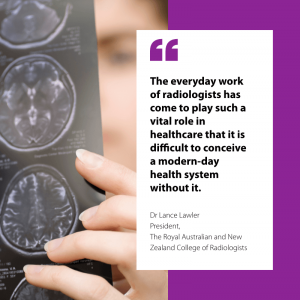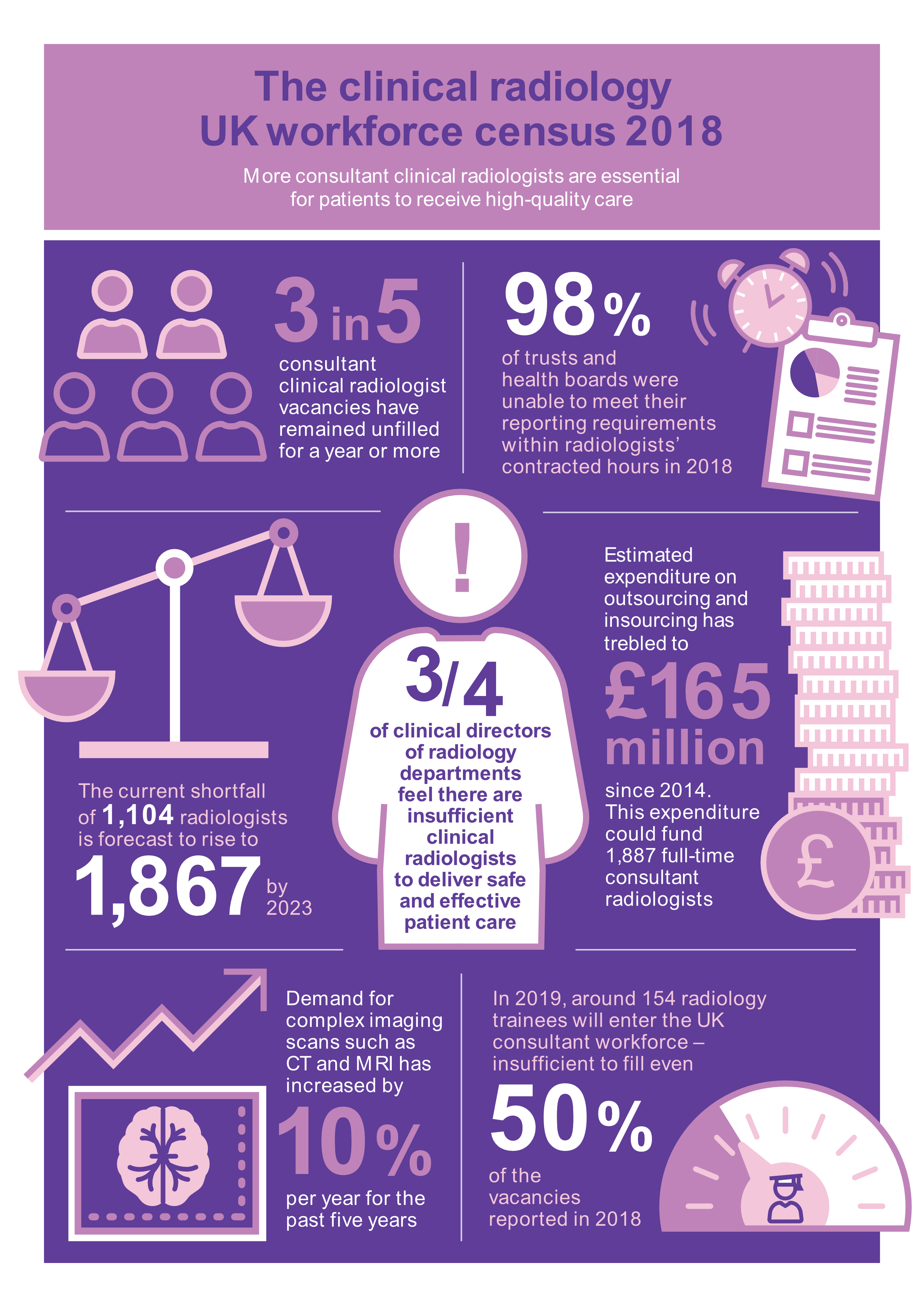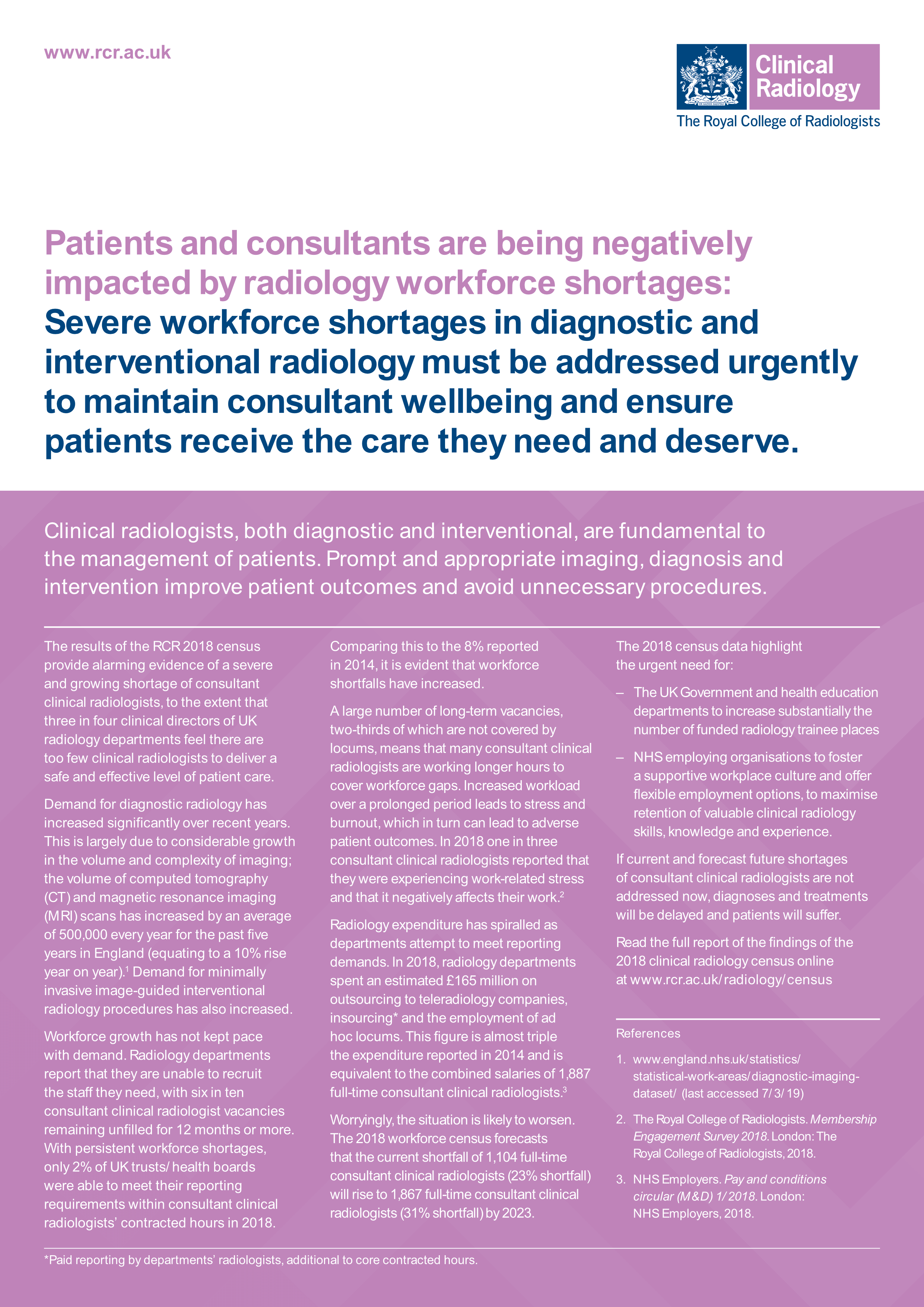
The Royal College of Radiologists (RCR) has today published the Clinical Radiology UK Workforce Report 2018, which highlights the pressures affecting both diagnostic and interventional radiology across the UK. The key findings included the statistic that 3 out of 5 consultant radiologist vacancies have remained unfilled for a year or more. This year, around 154 radiology trainees will enter the UK consultant workforce, which is insufficient to fill even half of the vacancies reported.
If current and forecast future shortages of consultant clinical radiologists are not addressed now, we as patients will suffer as diagnoses and treatment will be delayed.
The report can be found on the RCR website using the following link: 2018 CR Workforce Census Report.
The infographic can be found here: 2018 CR infographic (also see below).
The press release can be found here: April 2019 CR workforce press release.
This isn’t just an issue for the UK. LocumTenens.com, a US-based website agency for locums, reports similar issues identifying a number of issues, including a shortage of radiologists, increased procedure volume and shrinking reimbursements. A study going back as far as 2001 found that 45 per cent of hospitals were understaffed in radiology and called for a strategic radiology staffing plan. Although this has partially been addressed, state-to-state variations in radiologist and radiology resident workforces are high with a growing and ageing US population set the stage for greatly increased demand for physician services in coming years. Many of the nation’s population of radiologists are over 55, with the workload growing at about three times the rate of the graduate pool. It is projected that by 2025 there will be a national shortage of radiologists in the U.S. to the order of tens of thousands of positions.
In Ireland, the highest standards of practice cannot compensate for the current shortage of radiologists in Ireland, the faculty of radiologists, which is part of the Royal College of Surgeons in Ireland, has said.
The Royal Australian and New Zealand College of Radiologists asks why are radiologists one of the hardest jobs to fill in Australia with 36 per cent of positions remaining unfilled after 60 days. Over a third of radiologists are over 55.
A 2015 study in Japan concluded that the estimated numbers of CT and MRI interpretation reports and radiation treatment plans that one full-time radiologist could complete within 1 hospital day (8 h) were 19.9 and 1.22, respectively. To complete all CT and MRI reports, at least 2.09 times more full-time diagnostic radiologists are needed in Japan. For radiation therapy, at least 1.23 times more full-time radiation oncologists are necessary at large- and medium-scale hospitals, although the number of radiation oncologists needed in Japan is balanced to the current number.
Susan Oliver, the chair of Pseudomyxoma Survivor, is looking to push this issue onto the political agenda in the UK and will be lobbying parliament to address this serious issue. We’ll keep you updated with progress.
Addressing the shortage of radiologists., Hawkins J., Radiol Manage. 2001 Jul-Aug;23(4):26-8., PMID:11499079
. The Complexities of Physician Supply and Demand: Projections Through 2025. Center for Workforce Studies. https://members.aamc.org/eweb/upload/The%20Complexities%20of%20Physician%20Supply.pdf. Accessed April 12, 2019. Google Scholar
Nishie, A., Kakihara, D., Nojo, T. et al. Jpn J Radiol (2015) 33: 266. https://doi.org/10.1007/s11604-015-0413-6
Volume 14 No 2 / Mar 2018 Quarterly publication of The Royal Australian and New Zealand College of Radiologists. https://www.ranzcr.com/documents-download/newsletters/4611-inside-news-march-2018. Accessed April 12, 2019.


